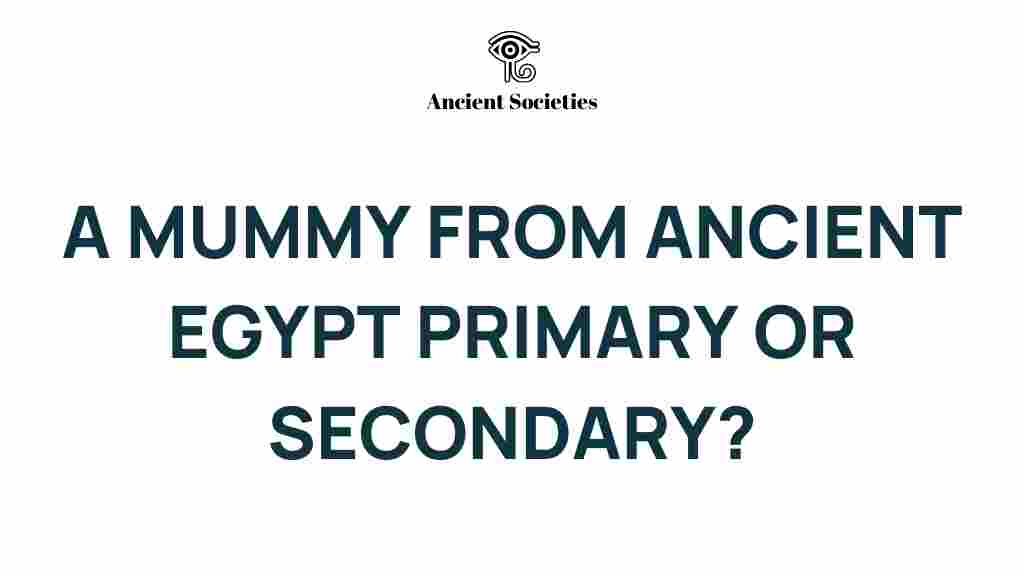Unearthing Secrets: Is This Ancient Egypt Mummy Primary Evidence?
Ancient Egypt is a civilization that has captivated the imagination of many, with its rich history, intricate culture, and remarkable artifacts. One of the most intriguing aspects of this ancient society is its burial practices, particularly the mummification process. In recent years, archaeological discoveries have unearthed mummies that provide primary evidence about the lives, beliefs, and practices of the ancient Egyptians. In this article, we will explore the significance of these mummies, the secrets they hold, and what they reveal about ancient Egyptian culture and history.
The Importance of Mummies in Archaeology
Mummies are more than just preserved bodies; they are key to understanding the past. The process of mummification was deeply intertwined with ancient Egyptian beliefs about the afterlife. Here are some reasons why mummies are considered primary evidence in archaeology:
- Preservation of History: Mummies have preserved not only the bodies but also artifacts that were buried with them, providing insights into daily life, social structures, and religious beliefs.
- Cultural Insights: The way mummies were prepared and the items found within tombs can reveal much about ancient Egyptian culture, such as their views on death and the afterlife.
- Scientific Study: Advances in technology allow scientists to perform analyses on mummies, leading to discoveries about health, diet, and diseases prevalent in ancient Egypt.
Discoveries of Ancient Egyptian Mummies
Over the years, significant archaeological discoveries have revealed mummies that have changed our understanding of ancient Egyptian culture. Some notable discoveries include:
- King Tutankhamun’s Tomb: Discovered in 1922 by Howard Carter, the tomb was filled with artifacts and a well-preserved mummy that provided insights into the life of the young pharaoh.
- The Mummies of the Valley of the Kings: This site contains a wealth of tombs and mummies of pharaohs and nobles, each telling a story about the ancient Egyptian elite.
- The Cache of the Royal Mummies: Found in 1881, this cache contained the mummies of various pharaohs and high-ranking officials, showcasing the burial practices of the time.
Understanding Mummification
The process of mummification was complex and involved multiple steps, each designed to prepare the body for the afterlife. Here’s a step-by-step overview of how mummies were created:
- Removal of Internal Organs: The internal organs were removed to prevent decay. The lungs, stomach, intestines, and liver were typically placed in canopic jars.
- Drying the Body: The body was desiccated using natron, a naturally occurring salt, which helped to dry it out and inhibit decomposition.
- Wrapping the Body: After drying, the body was wrapped in linen. Amulets and other protective items were often placed within the wrappings.
- Final Burial Preparations: The mummy was then placed in a coffin, which was often beautifully decorated and contained additional items for the afterlife.
Artifacts Found with Mummies
Artifacts play a crucial role in understanding ancient Egyptian culture. Items buried with mummies often included:
- Jewelry: Gold and precious stones that signify wealth and status.
- Funerary Texts: Scrolls containing spells and texts intended to guide the deceased through the afterlife.
- Everyday Items: Objects such as tools, games, and food offerings that reflect daily life and the deceased’s status.
Troubleshooting Tips for Understanding Mummy Discoveries
As fascinating as the study of mummies is, there are challenges that archaeologists and researchers face:
- Degradation: Over time, mummies and their artifacts can degrade, making it difficult to extract accurate data.
- Contamination: Modern chemicals and handling can contaminate ancient materials, skewing research results.
- Interpretation Issues: Cultural understanding evolves, and what was once believed may change with new discoveries or insights.
New Discoveries and Technologies in Mummy Research
Recent advancements in technology have revolutionized the study of mummies. Techniques such as:
- CT Scanning: Non-invasive imaging allows researchers to examine the internal structures of mummies without damage.
- DNA Analysis: Genetic testing can provide information about lineage, health, and even diet.
- Isotope Analysis: This technique can reveal information about the diet and geographic origins of the individuals.
These technologies have led to groundbreaking discoveries, enhancing our understanding of ancient Egyptian society and its complexities.
Conclusion: The Legacy of Ancient Egyptian Mummies
In conclusion, mummies are more than just remnants of the past; they serve as primary evidence of the rich culture and history of ancient Egypt. Through archaeology, we continue to unearth secrets that shed light on the beliefs, practices, and lives of this fascinating civilization. The study of mummies and their associated artifacts not only informs us about ancient Egyptian culture but also connects us to our shared human history.
As we continue to explore and discover, the mummies of ancient Egypt will undoubtedly reveal even more secrets, enriching our understanding of one of the world’s most enduring cultures.
For further reading on the significance of mummies in archaeology, check out this article on Archaeology.org.
To learn more about ancient Egyptian culture and its remarkable artifacts, visit our resources page.
This article is in the category Archaeology and created by AncientSocieties Team
